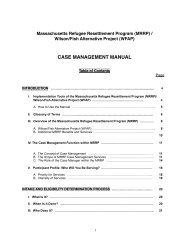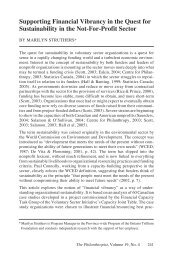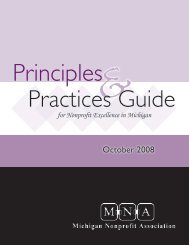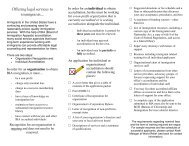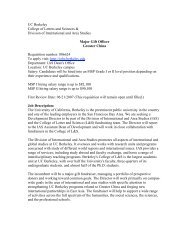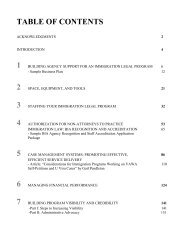Why Bad Presentations Happen to Good Causes - The Goodman ...
Why Bad Presentations Happen to Good Causes - The Goodman ...
Why Bad Presentations Happen to Good Causes - The Goodman ...
Create successful ePaper yourself
Turn your PDF publications into a flip-book with our unique Google optimized e-Paper software.
<strong>The</strong> Small Stuff<br />
(It’s Worth Sweating)<br />
Even when you have a presentation that is beautifully tailored <strong>to</strong> the audience and you are<br />
prepared <strong>to</strong> deliver it with enthusiasm and skill, you can still be undone by the little things.<br />
Experienced presenters know that their preparations for a talk are not complete until they<br />
have done their homework on the following items:<br />
Logistics<br />
Despite having their expectations lowered by a steady barrage of bad presentations,<br />
audiences still have some minimum requirements that must be met. <strong>The</strong>y expect <strong>to</strong> hear<br />
your voice and see your visuals without unduly straining their ears and eyes. If they have<br />
<strong>to</strong> take notes, they expect a level surface <strong>to</strong> write on. And they prefer room temperatures<br />
that avoid the arctic and equa<strong>to</strong>rial extremes.<br />
Since audiovisual equipment, room setups, and the event-planning expertise of your<br />
hosts will vary widely from location <strong>to</strong> location, it is incumbent upon you <strong>to</strong> nail down in<br />
advance all the details that help ensure a smooth, professional presentation:<br />
Room Setup<br />
If you want all audience members facing forward with tables in front of them, request<br />
“classroom style” seating. If you plan on breaking the audience in<strong>to</strong> smaller discussion<br />
groups, round tables (or “rounds” in event-planning parlance) are preferable, and these also<br />
provide a level surface for note taking. And if note taking is not essential and you prefer <strong>to</strong><br />
have the audience consolidated in a more intimate space, then “theatre style” seating (i.e.,<br />
parallel rows of chairs only) is the setup <strong>to</strong> request.<br />
Light and Sound<br />
Rooms with bright lights that cannot be dimmed or windows without shades can ruin<br />
presentations that rely on projected visuals. If you use PowerPoint, ask the meeting<br />
organizer if either (a) the LCD projec<strong>to</strong>r is sufficiently powerful <strong>to</strong> overcome any level of<br />
room lighting, or (b) lights can be lowered <strong>to</strong> accommodate PowerPoint or similar visuals.<br />
By asking in advance, you give the organizer time <strong>to</strong> shift the location of your presentation,<br />
if necessary, or <strong>to</strong> ensure that the right equipment is on hand.<br />
In a similar vein, when addressing enough people <strong>to</strong> merit a sound system, specify in<br />
advance (a) whether you prefer a podium microphone or a wireless clip-on, (b) if you need<br />
microphones for audience questions, and (c) whether or not they have backup systems in<br />
place should any of the front-line microphones fail <strong>to</strong> work properly.<br />
See Checklists <strong>to</strong> Go<br />
for a detachable<br />
summary of this section.<br />
pg. 65



